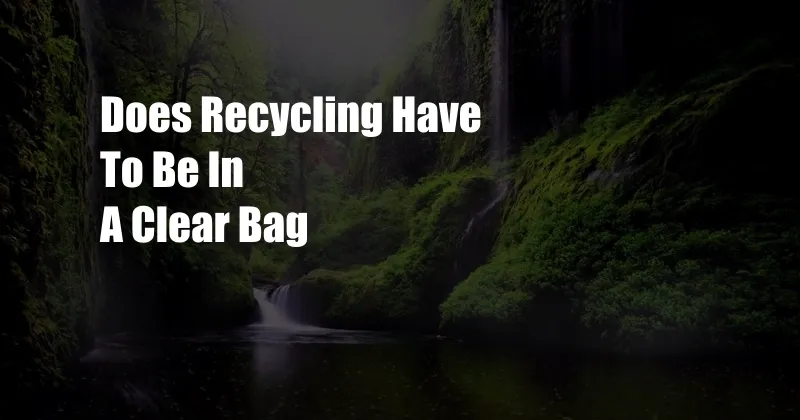
Does Recycling Have to Be in a Clear Bag? A Comprehensive Guide
My journey with recycling began with a simple act of tossing a crumpled paper into the blue bin. However, my enthusiasm waned when I discovered the complexities surrounding recycling guidelines. One prevalent question that left me perplexed was whether recycling had to be in a clear bag.
Unveiling the truth behind this matter led me on a quest to decipher the regulations and uncover the environmental implications. Join me as I delve into the intricate world of recycling, unraveling the intricacies of clear bags and their role in this process.
Clear Bags: Unraveling the Purpose
Clear bags serve a specific purpose in the recycling process. Their transparency allows recycling workers to easily identify the contents and avoid contamination with non-recyclable materials. By enabling quick visual inspection, clear bags streamline the sorting process, ensuring that recyclable materials find their way to the appropriate recycling streams.
Additionally, using clear bags for recycling promotes awareness and encourages informed disposal practices. When individuals can see the contents of their recycling, they become more mindful of what they are discarding and its environmental impact. This transparency facilitates accountability and fosters a sense of environmental stewardship.
Navigating Recycling Guidelines with Clarity
Recycling regulations vary across municipalities, so it is crucial to check with local authorities for specific guidelines. However, some general principles apply:
- Clear bags are often recommended: While not universally required, clear bags are frequently suggested for recycling to enhance visibility and simplify sorting.
- Exceptions exist: In certain cases, recycling programs may not necessitate clear bags. For instance, some municipalities have color-coded bins for different recyclable materials, eliminating the need for clear bags.
- Contamination avoidance: Always check for local regulations and follow proper disposal practices to prevent contamination with non-recyclable materials.
A Deeper Understanding of Recycling: History and Importance
Recycling has a rich history, dating back to the ancient world. In the 20th century, the concept of modern recycling emerged, driven by concerns about waste management and environmental conservation.
Recycling plays a vital role in promoting sustainability. It conserves natural resources by reducing the need for raw materials, minimizing landfill waste, and saving energy. Moreover, recycling helps combat pollution by diverting recyclable materials from incinerators and reducing greenhouse gas emissions.
Unveiling the Latest Trends in Recycling
Advancements in technology and changing consumer behavior have shaped the evolution of recycling practices. Some notable trends include:
- Single-stream recycling: This streamlined approach combines all recyclable materials into one bin, making recycling more accessible and efficient.
- Advanced sorting technologies: Optical sorters and robotic arms enhance the accuracy and efficiency of recycling sorting processes.
- Closed-loop recycling: This circular approach aims to create a sustainable cycle where recycled materials are used to produce new products, minimizing waste.
Expert Tips for Effective Recycling
Based on my experiences as a blogger, I have compiled valuable tips to optimize your recycling practices:
- Rinse and crush: Rinse out food containers and crush them to conserve space.
- Check labels: Familiarize yourself with local recycling guidelines and consult packaging labels for specific instructions.
- Educate yourself: Stay informed about best recycling practices and emerging trends to contribute effectively to environmental conservation.
A Comprehensive FAQ on Recycling
Q: What materials can I recycle in a clear bag?
A: Clear bags are typically used for recyclable materials such as paper, plastic, metal, and glass.
Q: Is it okay to mix different types of recyclables in a clear bag?
A: Yes, most recycling programs allow mixed recyclables in clear bags. However, check with your local authorities for specific guidelines.
Q: What should I do with non-recyclable materials?
A: Dispose of non-recyclable materials in designated waste bins. Contact your local waste management service for proper disposal guidelines.
Conclusion
Recycling in a clear bag is a simple yet impactful way to participate in the fight against waste and environmental degradation. By embracing this practice, we can collectively make a significant contribution to a cleaner, more sustainable future. Remember, every recycled item is a testament to our commitment to environmental stewardship.
I invite you to delve deeper into the fascinating world of recycling. Stay informed about the latest trends and advancements, and share your knowledge with others. Together, let’s create a ripple effect that transforms our communities into beacons of sustainability.